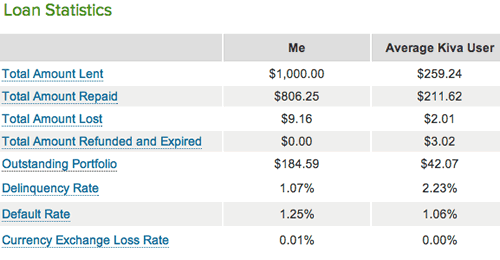
I have been lending some money to people through Kiva microfinance to help alleviate poverty since 2007. While reinvesting some funds that were paid back, I noticed that I just reached $1,000 in money lent out through 40 loans of $25 each. Kiva loans do not pay any interest. Out of the $1,000 that I have lent out, I have received about $805 back, about $185 is outstanding, and I have lost about $10. Now, you should know that the people borrowing this money are paying interest rates much higher than zero but much of that interest goes back to paying operational costs and covering defaults. There has been some debate as to whether this is becoming a form of predatory lending, but I believe there is a real need for such lending in these countries. You also have to trust Kiva in their selection of MFI field partners. I also do microfinance lending at Microplace.
Right now you can get a free $25 trial to try out Kiva using my invite link (I get nothing). You basically get to make a free $25 to a person of your choosing from a developing country, but when it is paid back you the money goes back to the sponsor. I know, rather cheesy. I think you should just have to keep lending it out by making it ineligible for withdrawal. That’s what I like about this type of lending – the money you commit can help many people over time.
 The Best Credit Card Bonus Offers – 2025
The Best Credit Card Bonus Offers – 2025 Big List of Free Stocks from Brokerage Apps
Big List of Free Stocks from Brokerage Apps Best Interest Rates on Cash - 2025
Best Interest Rates on Cash - 2025 Free Credit Scores x 3 + Free Credit Monitoring
Free Credit Scores x 3 + Free Credit Monitoring Best No Fee 0% APR Balance Transfer Offers
Best No Fee 0% APR Balance Transfer Offers Little-Known Cellular Data Plans That Can Save Big Money
Little-Known Cellular Data Plans That Can Save Big Money How To Haggle Your Cable or Direct TV Bill
How To Haggle Your Cable or Direct TV Bill Big List of Free Consumer Data Reports (Credit, Rent, Work)
Big List of Free Consumer Data Reports (Credit, Rent, Work)
Thanks Jonathan, just went ahead and made a loan to this guy via your referral, now seeing about referring some people myself.
Kiva is a good but it doesn’t really cater to many asian countries especially India due to some regularity issues. I do few through Kiva and also do use UnitedProsperity.com which concentrates on India and their mode of operation is slightly different compared to Kiva. I would urge you to check out and may be do help them out.
I’ve only recently “tiptoed into the water” in the area of peer-to-peer lending. I went with Prosper.com. Similar to what you talk about, I have placed money in indvidual loans in $25 increments. Prosper has a neat, if imperfect, rating system for their borrowers, ranging from AA down to HR (high risk). When I first got in, I spread my funds across a whole range of risk levels, including one HR rated loan. I was a bit taken aback when it went bad in only 2 months. However I am hopeful that the return on my other positions will absorb the loss and still yield a positive return on my total funds lent.
From an asset allocation point of view, I do not even consider this to be part of my portfolio. I view it more as money I would take to a casino in Vegas. If I win some back — with the added benefit of hopefully helping someone out with needed funds — that’s great. If I lose, well my expectations weren’t high to begin with. I do commend you on your approach to hopefully address poverty in the world; I may take a second look at Kiva myself.
You forgot one line… total profit.
So I’ve seen this around a bunch, and it’s not really my form of giving, but I’ve always wondered about how it works with taxes. Would you be able to claim losses as charitable contributions, or is the entire thing just considered making a gift loan (and possibly subject to more taxes if big enough)?
Of course when I tried to see if their website explained this, their “About” pages 404’s on me.
Kiva loans don’t pay interest, so there is no chance for profit. Any loan losses can be claimed as a capital loss, but it’s not a tax-deductible contribution as it was intended as a loan. You can give separately to Kiva (not a loan), and that is a tax-deductible contribution.
Microplace does pay some interest, as it is a for-profit institution.
Thanks for sharing your Kiva update with us!
Just wanted to say that Zidisha is a lesser known site that charges a lot less to the borrower than Kiva does. I am currently trying to draw attention to them to get more people engaged and offered a loan matching idea where if people who would normally fund Kiva would fund Zidisha instead (with a $25 loan) I’ll go ahead and invest $50 into a Kiva loan (in my name) so we get more exposure to Zidisha and Kiva doesn’t suffer in the process. No takers on my offer yet… but I remain hopeful.